DOWNLOAD
Over the course of its nearly thirty-five years, the U.S. Army Special Operations Command (USASOC) has had two Distinctive Unit Insignias (DUIs). What follows describes how both came to be and the symbolism in each design. It also details how the DUI changed to its current design, recognizable symbol of USASOC.
USASOC was provisionally established on 1 December 1988.1 When formally activated a year later, the new command was authorized a Shoulder Sleeve Insignia (SSI), DUI, and Major Command (MACOM) flag. In the interim, on 12 July 1989, Colonel (COL) Juan I. Chavez, Deputy Chief of Staff for Personnel, G-1, 1st Special Operations Command (1st SOCOM), a predecessor and then subordinate command of USASOC, requested that the U.S. Army Institute of Heraldry (TIOH) review proposed insignia designs for USASOC’s beret flash, airborne background trimming, DUI, and SSI.2 Both the DUI and SSI proposals were based on the red arrowhead SSI used by the lineage unit to Special Forces (SF), the World War II First Special Service Force (FSSF). Just nine days later, TIOH created and sent four separate DUI designs back to 1st SOCOM.3
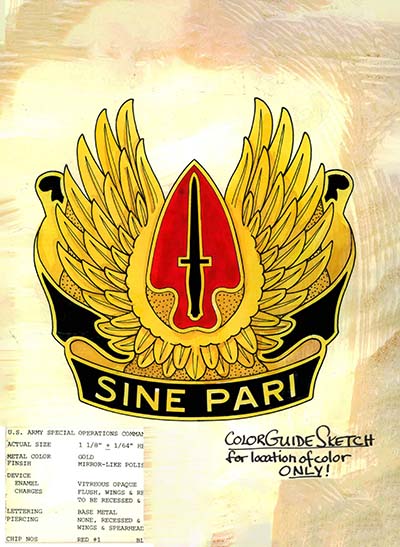
Brigadier General (BG) James A Guest, 1st SOCOM Commander, chose one of the designs with the Sine Pari motto.4 However, he requested a modification. Given its lineal connection to SF, ARSOF’s largest element, TIOH originally used the V-42 stiletto in the design. The V-42 was the knife carried by the FSSF, a symbol already present in the SF DUI. However, just like he had done with the proposed SSI, BG Guest wanted to use a Fairbairn- Sykes fighting knife, issued in World War II to some personnel in the Office of Strategic 2 Services (OSS) and the 1st Ranger Battalion.5 TIOH concurred with this request.
TIOH authorized the insignia after USASOC’s activation on 1 December 1989.6 Its final description was:
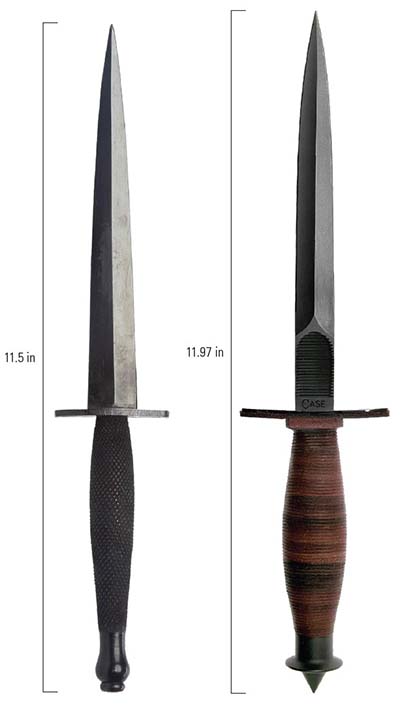
“The stylized spearhead alludes to the shoulder sleeve insignia worn by the 1st Special Service Forces and recalls the heritage and traditions that the U.S. Army Special Operations Command will perpetuate. The unsheathed dagger symbolizes total military preparedness and has long been associated with Army special operations forces. The gold wings surrounding the spearhead and symbolizing the command’s airborne and aviation missions, are raised to denote combat readiness. Gold is representative of merit and honor. Attached below the shield is a black and gold motto scroll bearing the Command’s motto ‘SINE PARI’ (Without Equal) in gold letters.7
Personnel assigned to Headquarters, USASOC, wore that DUI until late 2011. The process of replacing the original USASOC DUI began in 2009. The USASOC Commanding General, Lieutenant General (LTG) John F. Mulholland, along with Command Sergeant Major Perry L. Baer and Command Group, were very aware that the DUI did not represent the command well in the sense that it simply did not “resonate with the vast majority of ARSOF soldiers.”8 To get a better understanding of the then current DUI, LTG Mulholland requested an information paper from the USASOC History Office on its creation and symbology.9 Then, in late 2010, the Command Group tasked Mr. Daniel W. Telles, the Art Director for the History Office, with redesigning the front atrium of USASOC’s headquarters, the Major General Robert A. McClure building. Telles proposed a design that included the USASOC SSI superimposed on a globe. It met with LTG Mulholland’s enthusiastic approval.
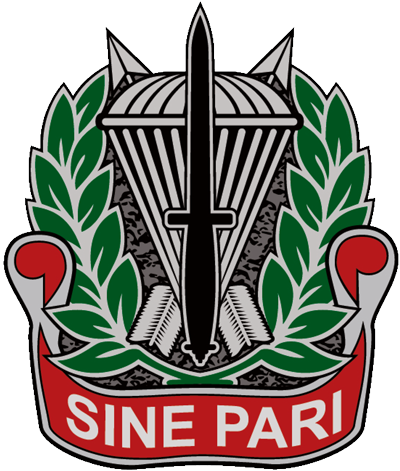
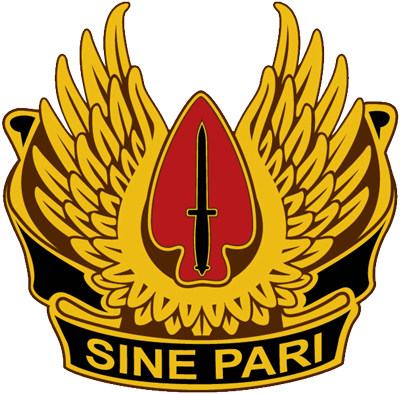
However, both LTG Mulholland and Mr. Telles saw that the new design had greater utility than just a small insignia for the command. Instead, it could be a key aspect of an effort to develop a USASOC ‘brand.”10 LTG Mulholland suggested that the design become the basis for a new DUI, noting that the arrowhead overtop the globe “emphasizes the command’s true nature and scope better than golden wings.”11 In so doing, LTG Mulholland was very deliberate in his methodology. As he recalled, “the guidance I gave to Dan was that I wanted our SSI to be situated on the globe [in order to] illustrate our global area of operations. More specifically, I wanted the portion of the globe that was visible to the viewer to specifically NOT be the typical display of the northern and southern American landmasses. I wanted the non-stated message of the image to be that our “normal” area of focus was abroad, not in the USA. Dan brought this powerful art-decoish design to life.”12
Meanwhile, LTG Mulholland also communicated the redesigned proposal with Major General (Ret) James A. Guest, who chose the original DUI. He wanted to ensure that MG Guest understood that while his prior efforts were much appreciated, there was a strong rational for changing the DUI. MG Guest was supportive.13 Once this was done, LTG Mulholland then forwarded Telles’ design to TIOH. Because TIOH typically will not consider redesigns of already approved insignia, it officially non-concurred with the redesign.14
Forewarned, Mulholland garnered Army support for a change in the DUI. He informed his friend LTG Thomas P. Bostick, Deputy Chief of Staff, G-1, U.S. Army, which had the authority to overrule TIOH, of the reason for the endeavor. LTG Mulholland then wrote Secretary of the Army John M. McHugh on 31 May 2011.15 He wrote, “Unfortunately, the truth is that few of the soldiers within USASOC identify with the DUI, as it is overwhelmingly perceived to be an aviation unit’s style DUI.” He continued, “USASOC has always had a global operational focus, and always will. Inserting the globe in lieu of the current golden wings is infinitely more representative and illustrative of where the men and women of USASOC operate.”16
On 10 August 2011, LTG Bostick approved Mulholland’s request.17 TIOH then worked with the USASOC Command Group and History Office to finalize the new design. It received formal approval on 5 October 2011, thereby superseding the old design. Still, the new DUI retained many elements of the old, such as the colors, spearhead SSI of the FSSF, the upturned Fairbairn-Sykes dagger, and the Sine Pari motto. The official description is:
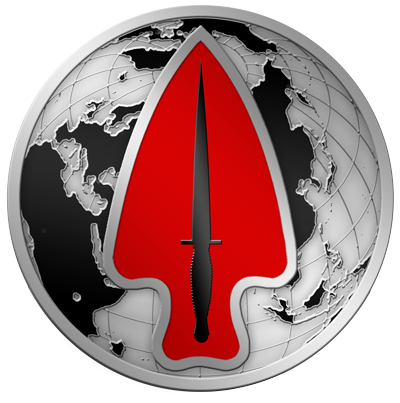
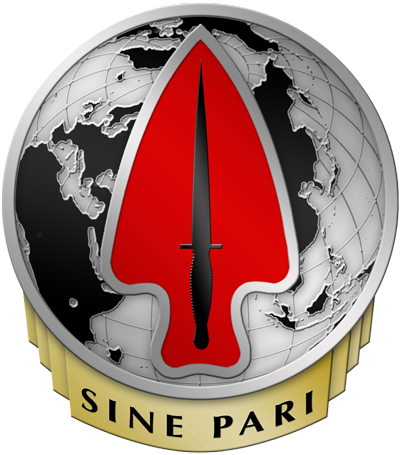
“The silver globe with land masses in black represents the ground combat domain that is our Nation’s Army Special Operations Forces operating environment within the joint special operations community. The stylized spearhead is based on the shoulder sleeve insignia worn by the 1st Special Service Force invoking the extraordinary fieldcraft and fighting spirit of Native American warriors. It further recalls the heritage and traditions that the US Army Special Operations Command has promulgated since its creation. The unsheathed dagger representing the Office of Strategic Services and the World War II Ranger Battalions symbolizes total military preparedness and readiness to service anytime, anyplace, anyhow. The gold scroll represents merit and honor and perpetuates the former insignia’s motto of ‘Without Equal.’”18
Although not included in the official description, Telles added seven segments in the Sine Pari motto below the globe. These represent the seven tribes of USASOC: Aviation, Rangers, Special Forces, Civil Affairs, Psychological Operations, the U.S. Army John F. Kennedy Special Warfare Center and School, and Army Special Operations Support elements.

The current DUI is now an often-used symbol to represent the command. However, it is also easy to forget that it has a backstory and is rich in symbolism from ARSOF history, thereby tying the past to the present. Remembering this incredible legacy will be important as USASOC moves forward in the coming year to face, embrace, and overcome increasingly difficult challenges.
